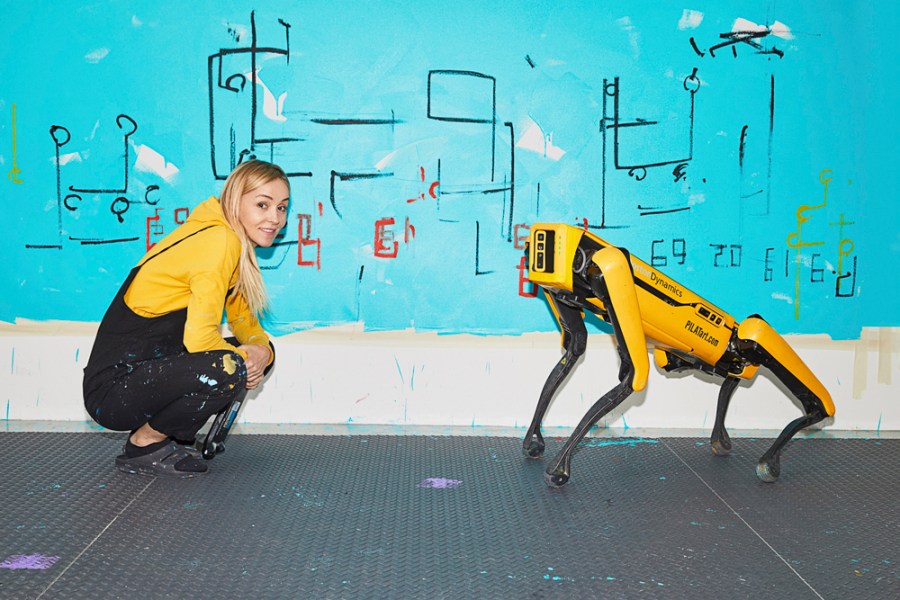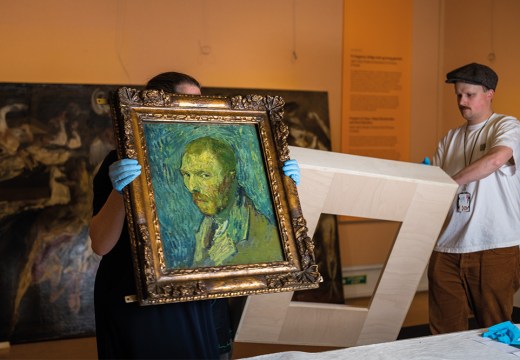The artist Agnieszka Pilat is best known for her work with Spots: dog-like robots designed by Boston Dynamics, which are more usually used by mining companies or militaries than by artists. Pilat is a Polish painter based in San Francisco. She has described herself as a ‘propaganda artist’ for technology, paints pictures of machines and trains robots to paint. Three Spots are currently taking part in a four-month ‘residency’ at her exhibition ‘Heterobota’ at the NGV Triennial in Melbourne (until 7 April 2024).
Where is your studio?
My main studio is in New York, on 26th Street in Chelsea, where many artists have their studios. My old studio in San Francisco is much more modest: it’s a converted garage in the Mission District.
I often work away from my workshops – say if there’s a company that has very precious equipment that can’t leave their studio. SpaceX is an example of that, in Hawthorne, California; I have a big wall space there where I can paint. I give them a few weeks’ heads up that I’m coming, and they will bring a machine to me – generally something they actively use. For example, I did a series called Dragon Hatch, which is named after an object that lets astronauts out into space. There’s one they use for training that they bring to me.

Installation view of Agnieszka Pilat’s work Heterobota on display as part of the NGV Triennial at NGV International, Melbourne. Photo: Sean Fennessy
I always make diptychs at SpaceX. I grew up in Poland, which is a very Catholic country, so I think about things like altars, diptychs, halos and gold leaf a lot. I see the work of SpaceX as embodying an almost religious aspect of technology. Technology and religion use very similar forms of seduction: promises of ecstasy, of utopia, of a better future. The cult of technology is growing, and I think we will see new religions springing from it.
There’s a lot of precious things in my studios so I try to be very neat, but it’s difficult because oil paints and gold leaf are kind of messy. Linseed oil and paint are flammable – I’ve never had an accident with them, but I always do take them back home with me just in case.

Music Band (2021), Agnieszka Pilat and four robots. Photo: courtesy the artist
How would you describe the atmospheres in your studios?
I like telling the story of new technologies in the old languages of paint and canvas, so the spaces feel like a hybrid of old and new. They smell like linseed oil, like an old-fashioned studio, but there’s also my robot – that gives them more of a tech factory feel. I use the robot to paint so the studio floor is covered up with marks from her little rubber feet, like the footprints of a dog or a series of stamps. When the war in Ukraine started, I made a painting for a fundraiser where I used the walking feet of my robot as a metaphor for the migration from Ukraine into Poland, where I was born.
Do you listen to anything while you work?
I always listen to audiobooks – it’s very hard for me not to listen to anything. There are audiobooks I return to over and over again. The audiobook I return to is Man’s Search for Meaning (1946) by Viktor Frankl. It’s very hypnotic – I know the book by heart, almost, but it puts me in the right mode.

Two Spot robots at work in Agnieszka Pilat’s studio. Photo: courtesy the artist
Do you have a specific studio routine?
I listen to an audiobook, paint for about two hours, have coffee, paint for another hour. If I’m at SpaceX I have lunch with engineers and other employees. I then go back to the studio and the audiobook, have another coffee and work until 6 or 7pm. When I’m in my own studio, I have a similar routine but start the day later.
I get quite lonely in my studio – being alone for six hours every day feels unhealthy. But when I take the robot for a walk, I always meet people. It feels very much like having a pet – though she’s not much liked by organic dogs. It’s also a bit of a provocation. It’s interesting to see how different reactions are: some people will be delighted, others angry.
When I first started painting with the robot, I operated it manually, so I didn’t really have a need or desire to have an engineer. But while preparing for my show at the National Gallery of Victoria, everything had to be automated and I needed an engineer to help me with that. We are together quite a bit; he visits once a week or so. It’s actually super scary, because I’ve never given away so much control. He puts my desires into code, but ultimately I lost that direct connection to the robot.

Agnieszka Pilat in her New York studio. Photo: Aaron Richter
What’s the most unusual object in your studio?
The robot is the weirdest object in my studio, I guess, though it doesn’t feel weird to me. But people stop in their tracks when they see it. I give my robots female genders and I feel very strongly that they are female – that’s also kind of weird, I guess: to assign technology a gender.
What’s your most well-thumbed book?
Ernest Becker’s The Denial of Death (1973). It talks about heroism and how the world is viewed as a system of heroes: living in the United States, they can be everyone from superheroes to big personalities in the tech world or billionaires. Everyone wants to be a hero. The idea of heroism is huge in America and this book helps me understand that a little more. It also reminds me to centre myself and think of myself as a hero, too.
‘Heterobota’ is at the Triennial at NGV International, Melbourne, until 7 April 2024.
Unlimited access from just $16 every 3 months
Subscribe to get unlimited and exclusive access to the top art stories, interviews and exhibition reviews.














![Masterpiece [Re]discovery 2022. Photo: Ben Fisher Photography, courtesy of Masterpiece London](http://www.apollo-magazine.com/wp-content/uploads/2022/07/MPL2022_4263.jpg)
Has arts punditry become a perk for politicos?